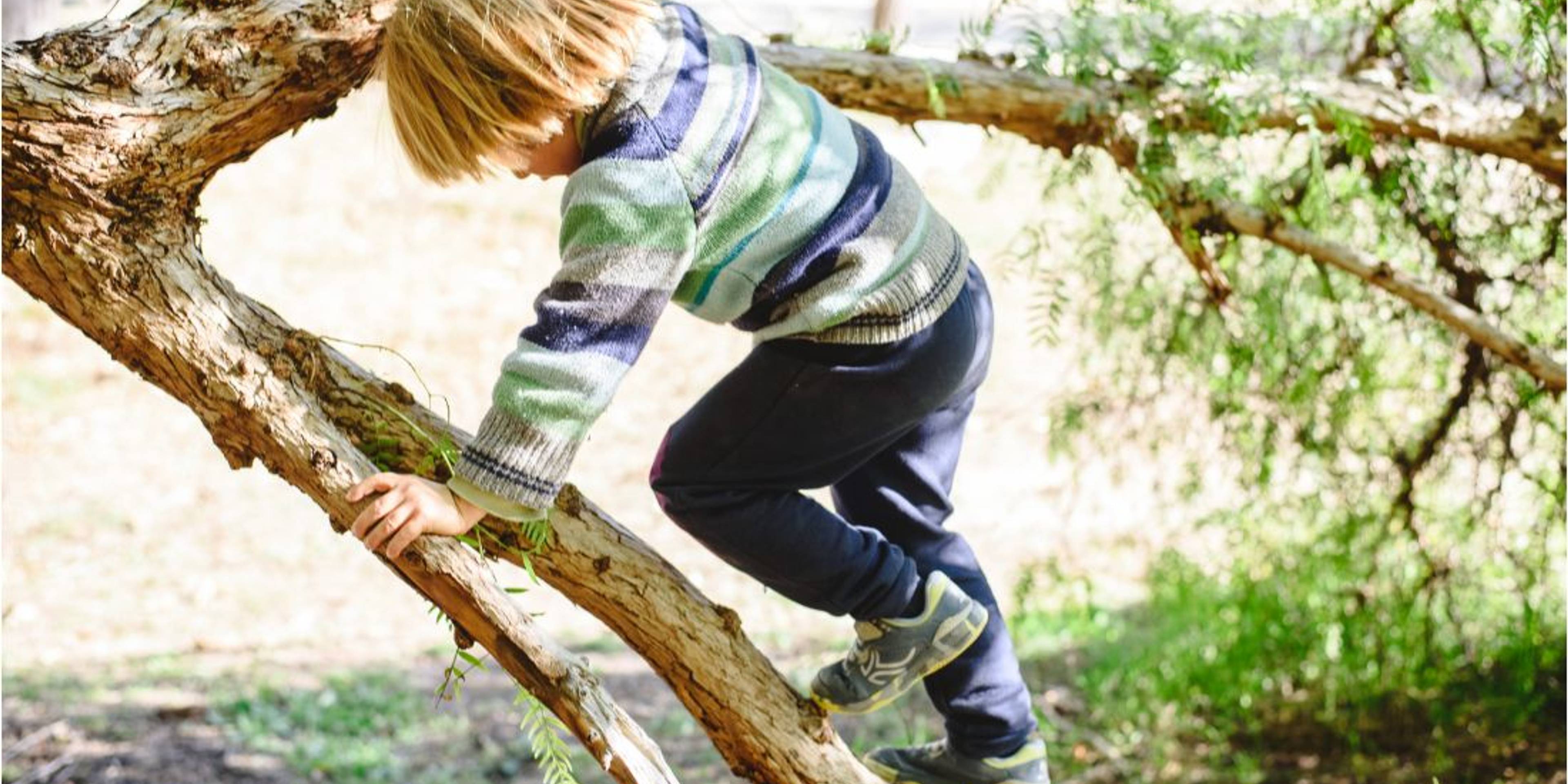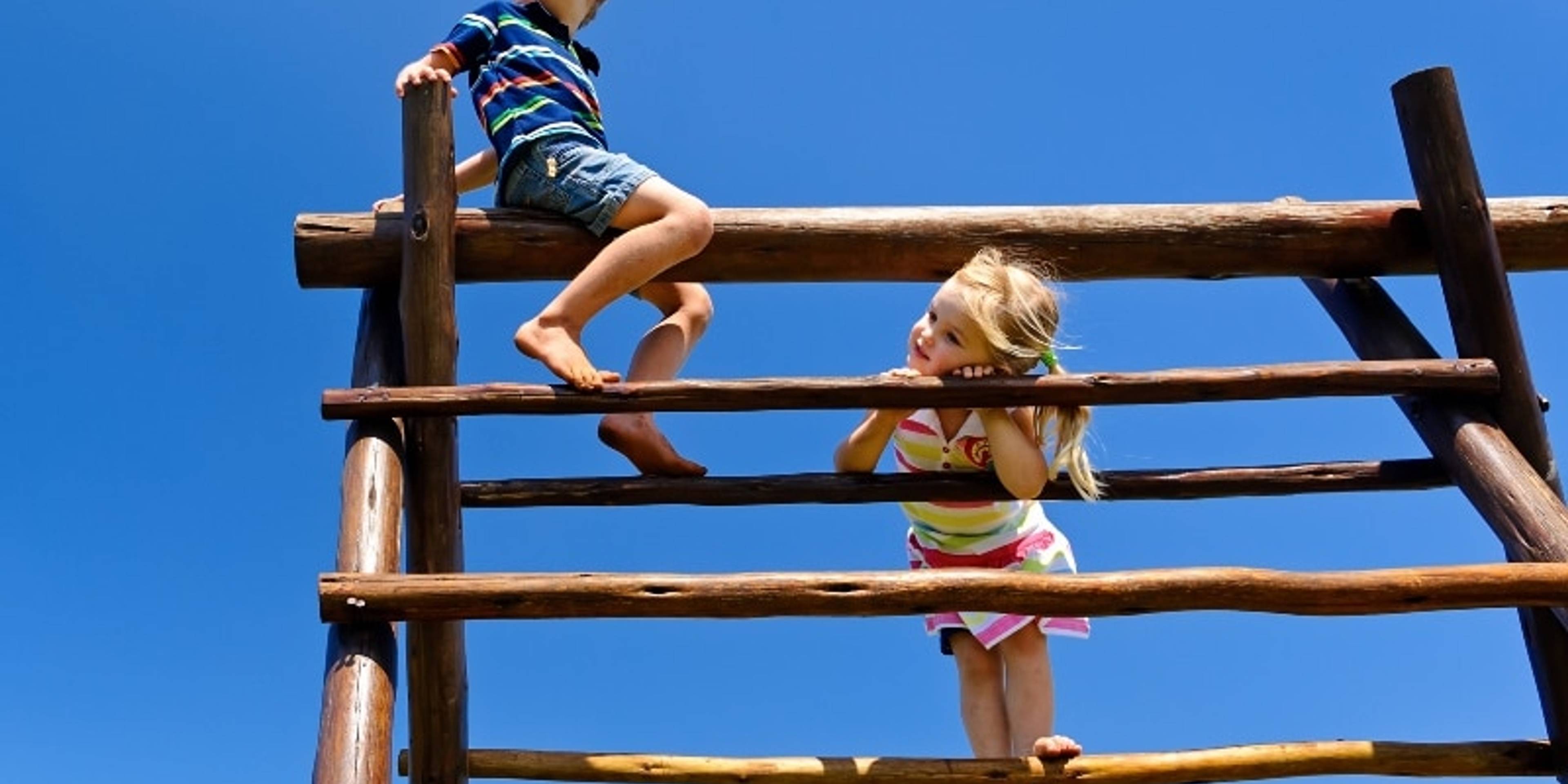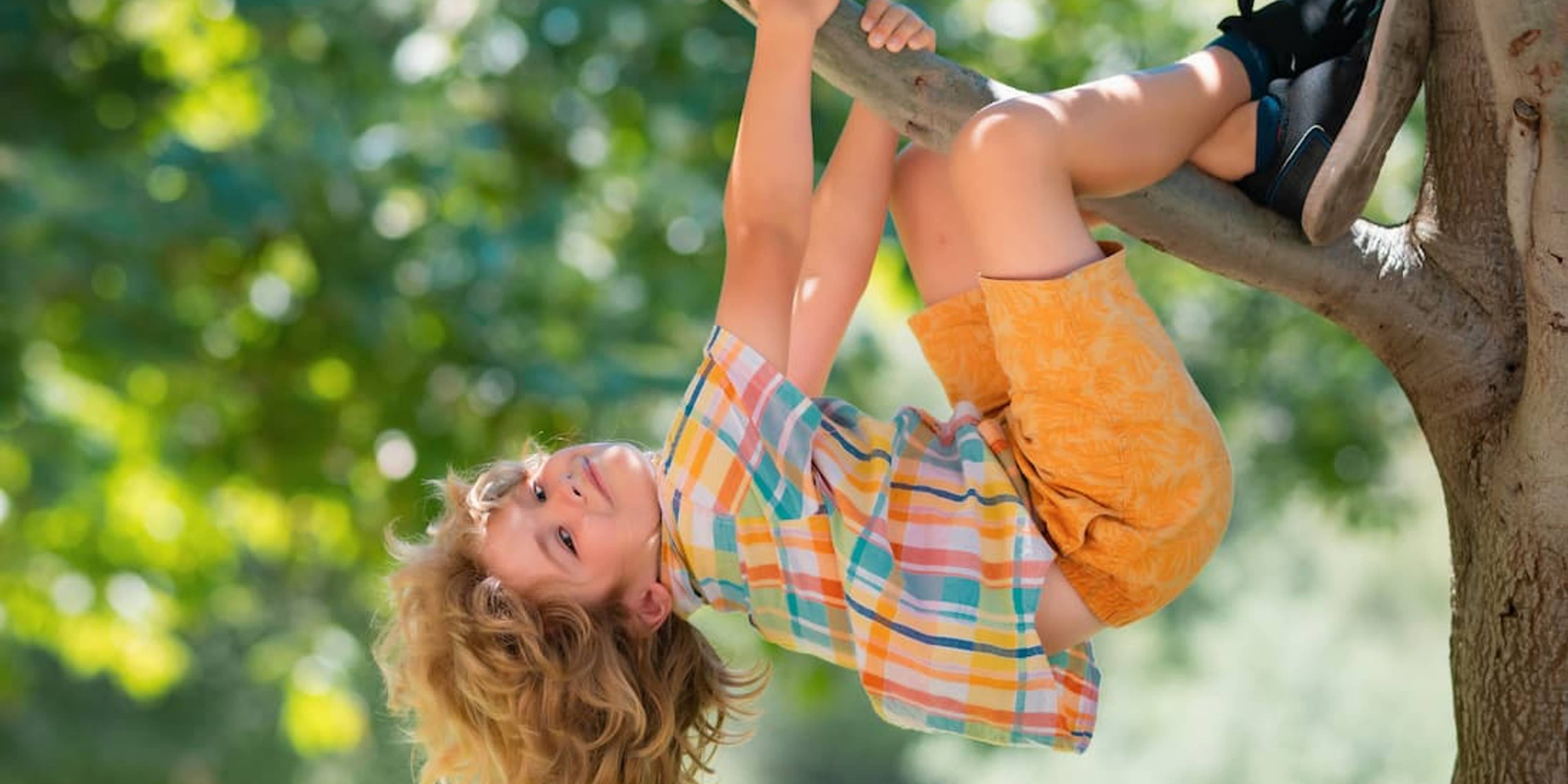April 22, 2025
Encouraging adventurous play in the preschool years
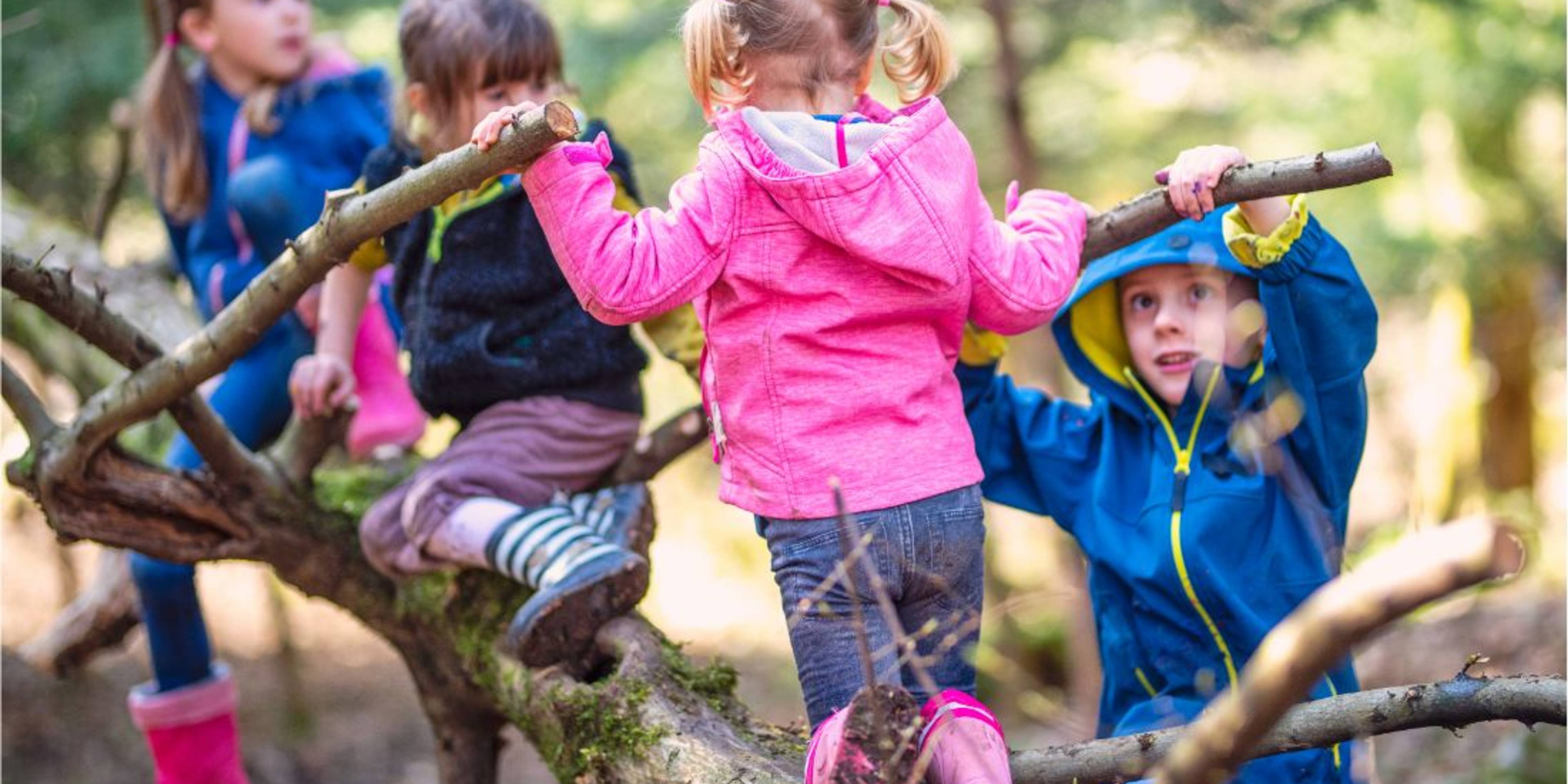
Tune into our podcast interview with April's researchers of the month here.
As well as providing numerous opportunities for exploration, joy, and expression, outdoor and adventurous play - the type of play that allows children to take age-appropriate risks - is associated with a range of positive health behaviours and outcomes. Yes, we're talking about the kind of play that might leave us adults with our hearts in our mouths at times, as children start to disappear up a tree, or engage in a rough and tumble game of chase. But its benefits are wide-ranging and known impacts include increased levels of habitual physical activity alongside better mental health and positive mood.
In 2019, Dr Hesketh was involved in the creation of physical activity guidelines in the UK, which explicitly note the importance of outdoor play for children in the preschool age group. We know quite a lot about the play habits of school-aged children, but until now, have had significantly less data on their younger counterparts.
Our Researchers of the Month, Dr Kathryn Hesketh and Professor Helen Dodd set out to discover how much time preschool-aged children spend playing in a range of indoor and outdoor spaces, and how adventurously they are playing within them. In the first national survey of play in children of this age, they asked over 1000 parents of two to four year olds about their children’s play habits, finding that, on average, children aged two to four spend around four hours per day (outside of educational settings) playing. Just under 50% of this was spent playing outdoors. Their findings shed interesting light on some inequalities in play, even in the youngest age group, which may exacerbate existing inequalities in health.
Summary
The survey showed that preschool-aged children living in Britain spend, on average, more time playing inside than they do outside, with the majority of play happening inside at home.
Outdoor play most often takes place in gardens or in other outside space at home, followed by playgrounds and in green space. Indoor play centres were also found to offer opportunities for adventurous play. The researchers also found that children living in rural areas play outside more than those living in urban areas, and also that white children tend to play outdoors more than those from ethnic minority groups. One of the survey’s most interesting findings is that preschool-aged girls spend much less time playing outdoors than boys. The British Children’s Play Survey of children aged five to 11 has already found similar (perhaps more expected) gender differences, but seeing stark disparities at this very young age surprised and shocked our researchers. As girls get older, their physical activity levels are generally less than boys of the same age. These findings indicate that girls are in a position of disadvantage from a very early age, with potential physical and mental health consequences.
"We were quite surprised by these findings – it’s concerning that at age two, we’re already seeing these differences in the time that boys and girls play outdoors in nature. Older children tend to be socialised to particular gender roles, and girls may then spend less time playing outside in nature. We didn’t expect to see this pattern as early as age two and given the link between playing outdoors and physical activity, girls may already be at a disadvantage very early in life.” (Dr Kathryn Hesketh, 2024)
The study does not explore reasons for these differences, but previous research indicates that they may be driven by a broad range of factors, such as the availability of local green space, exclusion from green space on the grounds of race, differential emphasis on academic learning versus unstructured play, and parenting pressures.
So why does all of this matter?
Well, risky play and adventurous play helps children to develop necessary life skills, explore risk-taking in a relatively safe environment and develop strong decision making and coping skills. Playing in this way can help to arm children with an anxiety toolkit. Early exposure to low-level feelings of fear and excitement, and to situations where they feel a little bit uncertain, give children opportunities to practise coping, and allow them to discover what physiological sensations of arousal (like butterflies or a racing heart) feel like. It can help them to realise that when they experience butterflies again, in a non-play environment, nothing bad will happen, which can make them more resilient to inevitable feelings of anxiety as they grow, and gives them confidence in their own judgement. Offering children the chance to engage in adventurous play, which normally occurs outside, is vital.
The study shows that at a policy level, there is important work and thinking needed around access to outdoor play spaces. A significant body of research indicates that not everyone feels welcome in these spaces, and some people have trouble accessing them. It’s vital to ensure that outdoor, natural spaces are available and welcoming for everybody.
Implications
"The results highlight inequalities in play even in the youngest age group, which may exacerbate existing inequalities in health." (Professor Helen Dodd and Dr Kathryn Hesketh, 2024)
Implications for parents
Let's try to consider how we might provide play opportunities, but also when we might inhibit play. Some children gravitate towards the adults present during play and miss out on the social elements of play with peers. Be mindful of this. It's important to both facilitate play opportunities with peers, and play with children ourselves.
Reflect on any anxieties you may have about your child’s involvement in adventurous play and whether or not these might be limiting. It’s healthy and normal to feel anxious about your child getting hurt during adventurous or risky play. But remember, what we do with any feelings of anxiety is impactful. Questions to consider might be: Do I encourage my child to take age-appropriate risks which might benefit them? If I always seek to protect them, what strategies might I use to give them a little more freedom? Could I allow them a little more time to make their own decision before intervening? If I know that I am particularly anxious about this kind of play, is there another adult in the family who is well positioned to take them on an adventure?
As children get older, empower them to understand that they can make good decisions. By the age of four, many children have a good idea of what they can do and what feels too much. Ask them, “How do you feel? Do you think you can do it?” Be their supporter!
If your child is anxious about adventurous play, be their cheerleader. Let them know that you have confidence in them and are there to help them if it goes wrong. Don’t intervene or stop them as soon as they express fear. Instead, as long as they are safe, gently encourage them. “Can you go one step higher? Can you stay one minute longer?” Support them through their anxieties and go through the journey with them.
Remember, exposure to fear within a safe environment is not a negative thing. Generally, when we are exposed to things that make us feel scared or uncomfortable, we learn that it wasn’t as scary as we feared and that we can cope with more than we think we can. Offering your children learning experiences like this will help to reduce anxiety.
Try to consider and interrogate how your gender perceptions might influence interactions with your children. The survey showed that male caregivers were less likely to let their daughters play adventurously than their sons. Remember that providing the same opportunities to both boys and girls allows them to gain insight into their own interests and limits.
Implications for educators
Consider risk-benefits carefully. Dr Hesketh and Professor Dodd note that childcare providers often feel constrained by safety regulations and that schools and early years settings generally take a risk-averse approach to play. However, the Play Safety Forum recommends that educators should consider the risk-benefits of play. Where there is risk, is that risk offering a benefit? And do the benefits outweigh the risks?
Last year, Professor Dodd worked with Play Wales to develop an early years toolkit to support outdoor play. This resource, which is packed with practical tips for early years settings, can be found here.
Primary settings might like to check out OPAL, an organisation which creates fantastic playtime programmes. Professor Dodd has evaluated the impact of their work, finding a decrease in negative emotions, fewer behavioural problems, and a hugely positive response from school staff, who noted that children with special educational needs and those who previously had social difficulties during playtime, were much happier, more engaged and better occupied.

Dr Kathryn Hesketh and Professor Helen Dodd
UKRI Future Leaders Fellows
Dr Kathryn Hesketh is a Behavioural Epidemiologist and Principal Research Fellow at University College London. She is an expert in movement behaviours during the transition to parenthood and during the first five years of life. Kathryn is a UKRI Future Leaders Fellow – her programme of work seeks to understand how movement behaviours influence health and wellbeing, and how we can better promote physical activity and play during pregnancy, postnatally, and in the preschool period.
Helen Dodd is Professor of Child Psychology at the University of Exeter Medical School. She is an expert in children’s play and mental health, with a particular interest in child anxiety. She also holds a UKRI Future Leaders Fellowship, which funds her research programme examining the role of adventurous play in preventing anxiety.
Dr Kathryn Hesketh and Professor Helen Dodd
UKRI Future Leaders Fellows
Related Resources
Scroll our research gallery

Dec 15, 2025
Crossing the line into cybercrime
As the most digitally connected generation so far, young people today face new challenges. Our latest Researchers of the Month, Professor Davidson and Dr Farr, have found that in the last decade, an increasing number of young people (particularly young men) have committed serious cybercrime offences, particularly hacking and money laundering. Their new book, written following a large research project funded by the European Union’s Horizon 2020 research and innovation programme, seeks to understand the drivers behind this trend. It explores a range of potential factors that may lead young people to engage in risky online behaviours, and to identify effective pathways for prevention.

Nov 16, 2025
Supporting Children’s Use of AI
Children and young people are now growing up surrounded by AI, and the landscape is shifting fast. In the UK, recent data from Ofcom and Internet Matters suggests that around half of children aged 8–17 regularly use generative AI tools such as ChatGPT, Bard or Snapchat’s MyAI. Many describe these interactions as feeling like conversations with a friend. A recent report from Common Sense Media found that 33% of teens had actually chosen to talk to an AI companion instead of a real person about something important or serious. Whether children are asking voice assistants to answer their questions, relying on chatbots for bedtime stories, using learning apps for revision or engaging with large generative AI models, it’s essential to remember that most of these systems were built with adults in mind, not children. They often assume levels of attention, memory and emotional maturity that younger users simply don’t have. Even older children and teenagers, who increasingly use AI as a supportive confidante (often without adult supervision or knowledge), are still learning to navigate boundaries around trust, identity and emotion. Our latest Researcher of the Month, Dr Nomisha Kurian, wants this to change. She has developed a new framework called Developmentally Aligned Design (DAD), which outlines how AI can be built with children’s needs, vulnerabilities and strengths at its core. She also chatted to us at Tooled Up, sharing practical tips on recognising when children may be relying too heavily on AI for emotional connection, how to talk to them about healthy boundaries, and how parents and educators can help children and young people use AI tools safely, creatively and critically.
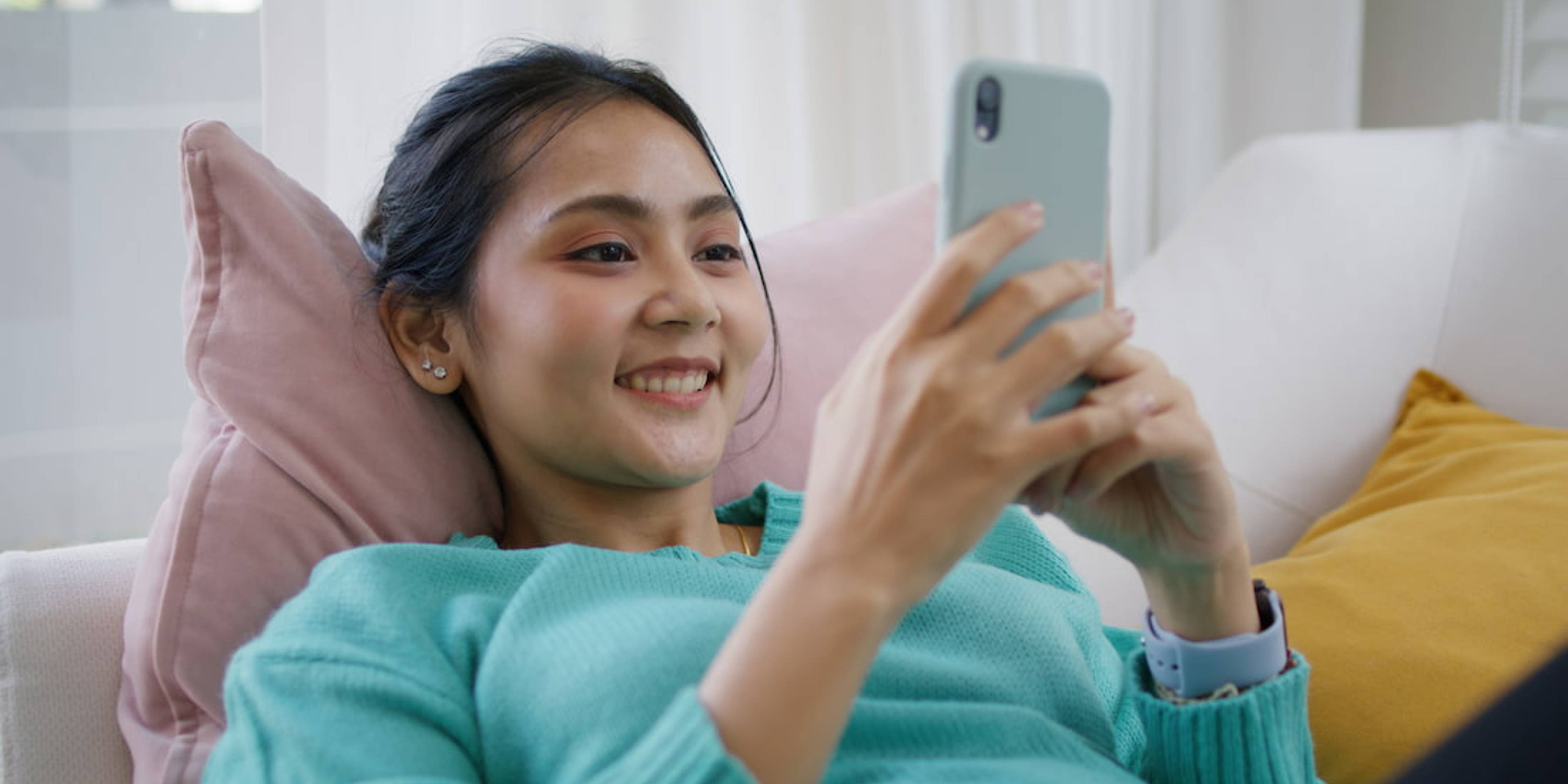
Oct 16, 2025
Algorithmised Girlhood: Teenage Girls and TikTok
As part of the early stages of her PhD study, our latest researcher of the month, Chiara Fehr, ran several focus groups about experiences of TikTok with eight 17 year old girls. Using creative methods, such as ‘TikTok show and tells’ a collaging session and a utopic mapping exercise, Chiara is exploring whether dominant narratives around growing up in a digitised world reflect the real life experiences of teens, and has summarised her findings so far in a recent article.
![“[They use devices] alllllllll day long”. What do children think about our tech use?](https://cdn.sanity.io/images/jxfh43in/content-prod-d2c/79f219275088655f59590f61ff29b6bc8b0d77f8-1100x733.jpg?w=3840&h=1920&q=70&fit=crop&crop=center&auto=format)
Sep 09, 2025
“[They use devices] alllllllll day long”. What do children think about our tech use?
We're all used to reading about children and young people's increasing use of digital tech. But what about adults' use? And what impact might our tech use have on family life? Parents today are spending an unprecedented amount of time on their devices. One study found that parents spend an average of nine hours per day engaged with screen devices. Over four hours of this is on smartphones, averaging 67 phone checks per day. Despite children's central role in family life, their voices and perspectives on the device use of the adults around them have been largely neglected in research. Along with colleagues, our latest Researcher of the Month, Professor Cara Swit, has published a fascinating study exploring the experiences and perceptions of children aged six to nine about their parents’ device use at home and its impact on them.

Aug 13, 2025
Students’ views on smartphone bans
In recent years, banning or restricting children’s access to smartphones and social media has grasped the attention of policy makers, schools and parents. A number of countries, including France, Turkey, Norway, Sweden, and regions of the US and Canada have introduced laws, policies or guidance for schools to ‘ban’ or heavily restrict the use of phones. Within Ireland, in 2024, the Minister for Education announced her intention to introduce smartphone bans in post-primary schools, whilst at the same time acknowledging that individual schools are best placed to decide on the scope and scale of restrictions for their students. Whilst these bans aim to protect children from harm, and teachers often anecdotally report seeing benefits, evaluations of existing research highlight a lack of evidence on their efficacy. At the moment, we simply don't know enough about the impact of bans. Evidence is hampered by the fact that technological developments and technology use is moving at a faster pace than research. Some studies suggest that bans are beneficial to academic outcomes and mental wellbeing. Others suggest no effects. However, many studies have methodological weaknesses, use small samples or retrospective data, and can't ascribe causal mechanisms. Our latest Researcher of the Month, Dr Megan Reynolds, has recently published a paper which explores young people's perspectives and experiences of smartphone bans in their schools. Unlike most previous research, it centres student voices in this high profile issue.

Jul 14, 2025
Do teens with mental health conditions use social media differently than their peers?
As Luisa Fassi, our new Researcher of the Month, comments, "The link between social media use and youth mental health is hotly debated, but hardly any studies look at young people already struggling with clinical-level mental health symptoms". In fact, Luisa's large systematic review and meta-analysis found that only 11% of papers published on the topic since 2007 focused on young people with clinical conditions. Her review also showed that the data used to evidence mental health conditions in these existing studies is not always strong or especially robust. Many report links between social media and mental health on the basis of short self-report questionnaires, where young people are asked about symptoms. Whilst this wasn't found as part of Luisa's review, it is also the case that very few papers in the field differentiate between different mental health conditions, or examine different symptoms or conditions (such as anxiety, ADHD or eating disorders) in isolation. To address this research gap, Luisa and colleagues have recently published a fascinating and nuanced paper. It analyses both quantitative and qualitative dimensions of social media use from a nationally representative survey of 3,340 teens in the UK aged between 11 and 19 years old, which was conducted by NHS Digital in 2017. Rather than gathering mental health data from self-report questionnaires, the young people in the survey underwent a full clinical screening, which included interviews with the young people, their parents and teachers. Information about social media use came from questionnaires completed by participants. They were not asked about specific platforms. Luisa used this data to gather novel insights into how social media and mental health are related in teens who both meet and do not meet diagnostic criteria for a wide range of mental health conditions. The study does not establish any causal links, but it does reveals a range of differences between young people with and without mental health conditions when it comes to social media.

Jun 17, 2025
Navigating the feed: younger adolescents' reflections on algorithmically curated social media
Our latest researcher of the month, Roxana Pomplun, has investigated the interactions, experiences and perceptions of younger adolescents, aged 11, 12, and 13, with algorithmically curated platforms such as TikTok, YouTube Shorts, Spotlight on Snapchat and Reels on Instagram. These kinds of platforms use algorithms to personalise and tailor feeds, harnessing user data to suggest content that the individual is most likely to be interested in and engage with. As such, young people have little control over what they are seeing in their feeds. Tech companies are not yet required to be transparent about the data that they are collecting, but it tends to include demographic information such as age, gender or location, along with use patterns. Whilst these sites dominate the digital lives of tweens and teens, until now they have received little dedicated research attention, particularly in relation to younger users, with most existing studies focusing on older teens. Whilst we know that most social media platforms have age limits of 13, we also know that many younger children are active users, particularly of algorithmically curated platforms like TikTok and YouTube Shorts. Given that early adolescence is a life phase marked by critical neurological development, identity development and heightened susceptibility to mental health issues, deepening our understanding of how younger adolescents engage with social media is vital. Roxana's qualitative research, where a group of young people eloquently explore their own experiences and perceptions, broadens our knowledge of social media use within an age group that appears increasingly aware of the digital influences shaping their online experiences, yet which is still in need of support to fully navigate these ecosystems.

May 15, 2025
Looking beyond smartphone bans
Over the last year or so, there has been a surge in public concern around smartphones and social media. Banning or restricting children’s access to smartphones and social media has grasped the attention of policy makers, schools and parents. A number of countries, including France, Turkey, Norway, Sweden, and regions of the US and Canada have introduced laws, policies or guidance for schools to ‘ban’ or heavily restrict the use of phones. In the UK, there are proposals to raise the age of ‘internet adulthood’ from 13 to 16, and to ban smartphones in schools. The third reading of a private members’ bill on this topic will be heard in parliament in July. Whilst these bans aim to protect children from harm, recent studies highlight a lack of evidence on their efficacy. Along with a team of international experts, our latest Researcher of the Month, Professor Victoria Goodyear, argues that, in isolation, banning smartphone and social media access fails to equip children for healthy use of technology. She suggests that there is a need to shift debates, policies and practices away from a sole focus on restricting smartphone and social media access, toward an emphasis on nurturing children’s digital skills for healthy technology use, and a rights-respecting approach which is underpinned by age-appropriate design and education.
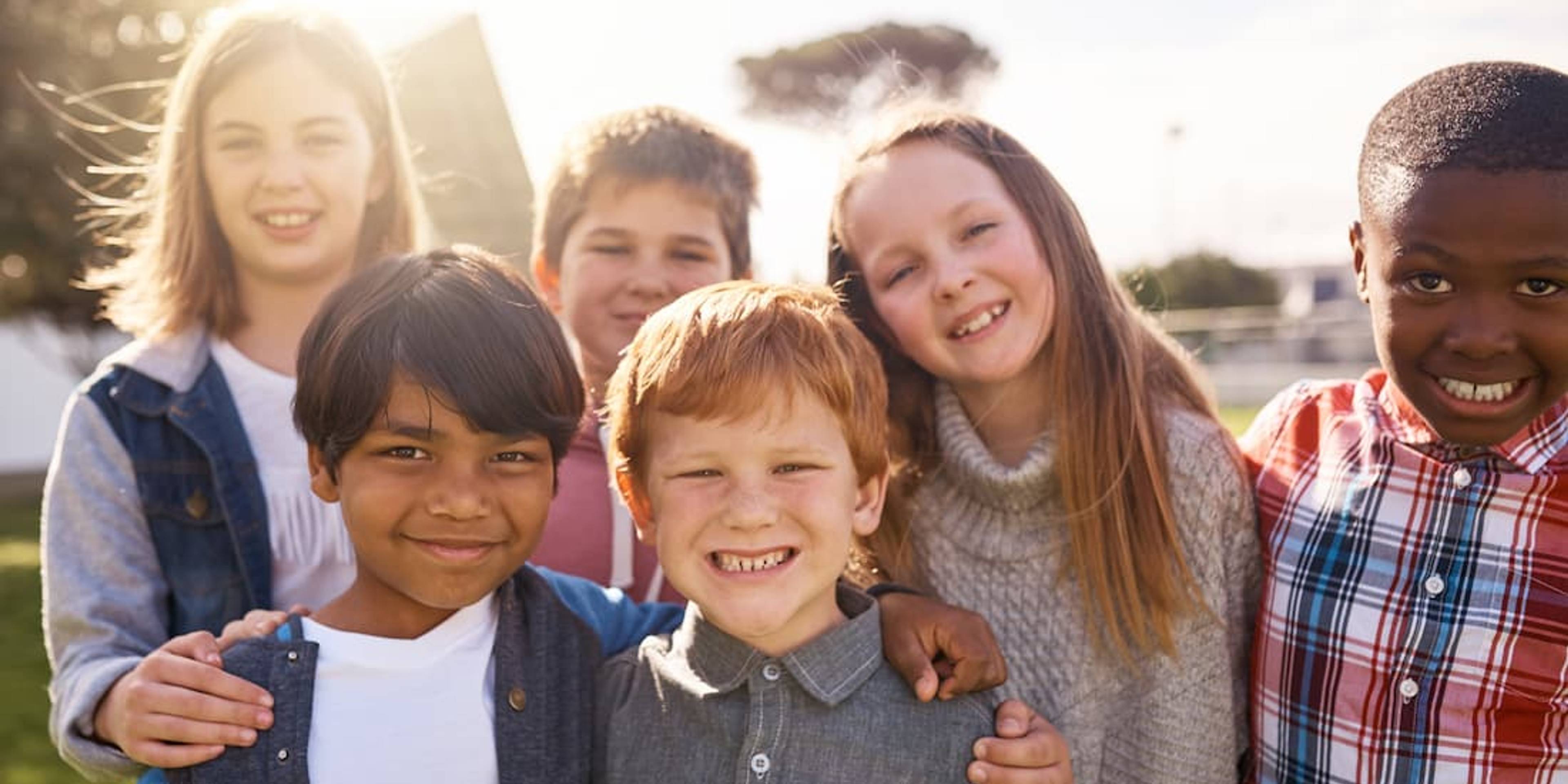
Mar 17, 2025
Fostering a school culture against bullying: the KiVa Programme
Bullying is an extremely important public mental health risk. Around one in five primary school children report being bullied at least weekly. Children who are bullied are more likely to experience depression and anxiety, and are at heightened risk of mental health issues in adolescence and adulthood. Whilst schools in England and Wales are required to have anti-bullying policies, rates of bullying remain high. Bullying is preventable, but schools need more help to tackle it. Typically, school policies focus on how to handle bullying once it happens. However, evidence suggests that a comprehensive approach involving the entire school to prevent bullying, alongside clear strategies for addressing confirmed cases, is the most effective way to tackle the issue. KiVa is one such whole-school approach, developed in Finland by Professor Christina Samivalli. A large study in Finland which involved 28,000 primary school pupils found that adopting the KiVa programme in Finnish schools significantly reduced bullying and improved children's mental wellbeing. The programme has since been rolled out nationally by the Finnish government and ongoing use of KiVa in Finnish schools is associated with year-on-year incremental reductions in bullying. Along with colleagues, our researcher of the month, Professor Judy Hutchings OBE, has tested the effectiveness of the KiVa Programme in UK primary schools. The study involved over 11,000 children in Wales, Birmingham, Oxfordshire and Devon, and showed a 13% reduction in reported rates of bullying when compared with existing school approaches to tackle bullying.
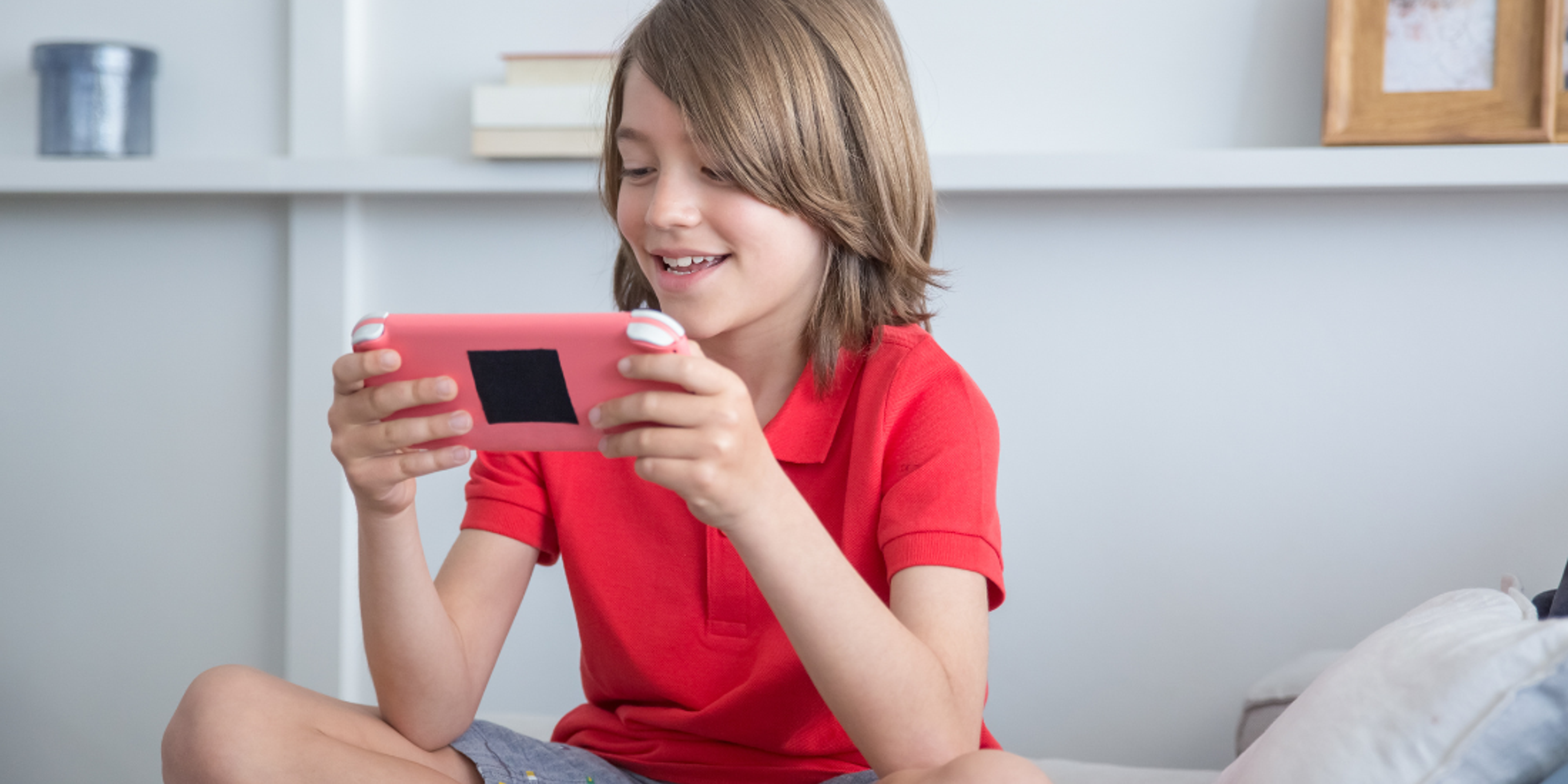
Feb 12, 2025
When is the right age? Searching for age-appropriate ways to support children's online lives
Currently, children's and young people’s use of digital technology is rarely out of the news. Age limits are debated. Calls for stronger limits are made, and questions are raised regarding whether society should ban 'under-age' children from various aspects of the digital world. 13 years of age is often cited as a digital 'age of consent', though this varies in some countries. Commonly used age limits are largely arbitrary, based primarily on US legislation, rather than evidence. In a recent paper, our researcher of the month, Dr Kim Sylwander, and her co-author Professor Sonia Livingstone, consider age milestones and evaluate whether or not the evidence supports them. Are age limits the optimal way to regulate children’s digital experiences? Does it matter that they are widely contested and often poorly implemented? And are common boundaries even the “right” age, according to evidence from the field of children and digital media? Dr Sylwander persuasively argues that moving forward, a developmental approach can better support children’s rights.
